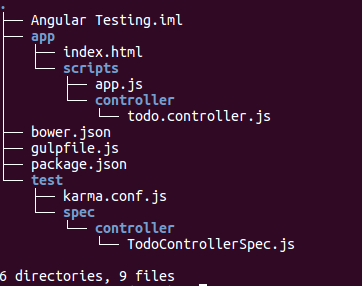Testing Controller in AngularJS
In Part 1 Part 2 and Part 3 of this article we didn’t talk a lot about testing. Those 3 parts were more focused on configuration required to do testing.
In this article I’ll show you how we can test simple AngularJS Controllers.
Here’s the folder structure that we are going to use.

Here are content of those file if you want to follow along
We are going to write our test on TodoControllerSpec.js. Before writing the test let’s look at todo.controller.js
(function(angular) {
'use strict';
angular
.module('app')
.controller('TodoController', TodoController);
TodoController.$inject = ['$scope'];
function TodoController($scope) {
$scope.todos = [
{'title': 'First Todo', 'done': false}
];
$scope.add = add;
$scope.clearCompleted = clearCompleted;
//~~~~~~~~~~~~~~~~~~~~~~~~~~~~~~
function add() {
$scope.todos.unshift({'title': $scope.newTodo, 'done': false});
$scope.newTodo = "";
}
function clearCompleted() {
$scope.todos = $scope.todos.filter(function(todo) {
return !todo.done;
});
}
}
})(angular);
If you look at above code snippet carefully you can see that the controller has convenience method to add() and clearCompleted() to add the Todo and Clear the completed Todo.
Since we are going to write the unit test we can ignore the HTML file and focus on business logic.
Open TodoControllerSpec.js and create the suite by using describe(). Here’s the full content of TodoControllerSpec.js if you want to peek at it.
describe('Test for TodoController', function(){
});
Now we need to initialize the module we can do that by using module function.
describe('Test for TodoController', function(){
beforeEach(angular.mock.module('app'));
});
Now that module is loaded we need to resolve reference of $controller service we can do that by using inject()
describe('Test for TodoController', function(){
beforeEach(angular.mock.module('app'));
var $controller;
beforeEach(angular.mock.inject(function(_$controller_) {
$controller = _$controller_;
}));
});
Now we have reference of $controller service which can be used to get initialize our TodoController.
First of all let’s create the inner suite to test the add() functionality of our controller.
describe('Test for TodoController', function(){
beforeEach(angular.mock.module('app'));
var $controller;
beforeEach(angular.mock.inject(function(_$controller_) {
$controller = _$controller_;
}));
describe('Test add functionality of Controller',function(){
});
});
Inside of new suite we will write some unit test using it(). On each on every test we need our TodoController so this is a good candidate for using beforeEach(). Let’s initialize TodoController.
describe('Test add functionality of Controller', function() {
var controller;
var scope;
beforeEach(function() {
scope = {};
controller = $controller('TodoController', {
$scope: scope
});
});
});
To initialize the TodoController we use $controller service. First argument $controller accepts is the controller name.
Second arguments on the curly braces are the dependencies that the controller has. I know I told you that we will be testing the controller that doesn’t have any dependencies. But relax it is just $scope.
We are ready to write some unit tests. If you looked at the code you will see that we have default todo. So when our app starts there must be atleast one todo in the list. Let’s check that with some expectation.
describe('Test add functionality of Controller', function() {
var controller;
var scope;
beforeEach(function() {
scope = {};
controller = $controller('TodoController', {
$scope: scope
});
});
it('Should have 1 todo at first', function() {
expect(scope.todos.length).toEqual(1);
});
});
In above test we are expecting that there must be exactly 1 todo on the scope.
Let’s add some more test for add behaviour.
it('Should add new Todo when click go', function() {
scope.newTodo = "Second Todo";
scope.add();
expect(scope.todos.length).toEqual(2);
});
it('Should add new todo at top of list', function() {
scope.newTodo = "Second Todo";
scope.add();
var addedTodo = scope.todos[0];
expect(addedTodo.title).toBe('Second Todo');
expect(addedTodo.done).toBe(false);
});
it('Should Clear scope.newTodo after add()', function() {
scope.newTodo = "Second Todo";
scope.add();
expect(scope.newTodo).toBe("");
});
The first test adds the new todo and checks the length of todos and see if its incremented by 1 i.e 2 for us.
Second one also adds the new todo but it checks to see if todo is added in top. Since we are using unshift it should add todo on top of the list.
Third one simply checks if newTodo properties is cleared after todo was added.
Like wise you can create the test to check the behaviour of clearCompleted. Here’s how I wrote the test
describe('Test should clear completed todos', function() {
var controller;
var scope;
beforeEach(function() {
scope = {};
scope.todos = [
{
'title': "One",
'done': false
}, {
'title': "Two",
'done': true
}, {
'title': "Three",
'done': true
}
];
controller = $controller('TodoController', {
$scope: scope
});
});
it('Should clear completed todos', function() {
scope.clearCompleted();
expect(scope.todos.length).toBe(1);
});
it('Should clear completed todos', function() {
scope.clearCompleted();
var remainingItem = scope.todos;
remainingItem.forEach(function(item) {
expect(item.done).toBe(false);
});
});
});
To run the test you can use gulp test. You can see the result on terminal.
In this post you got familier with basic unit testing capabilities for an angular controller. We will see some more advance angular testing using mock services in next part of this series. Until we meet again. GOOD BYE !!